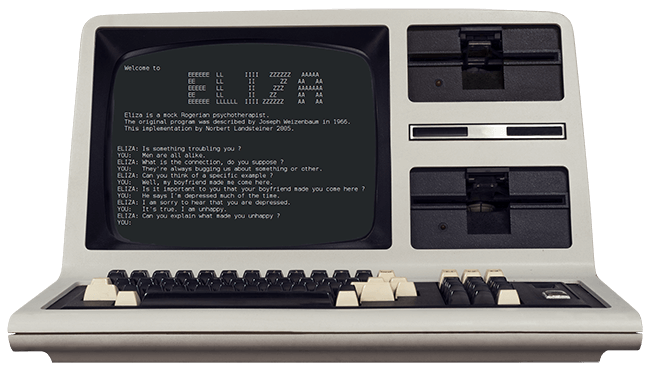By StoryFile Team
Meet ELIZA, understood by many as the first chatbot. Eliza was born in the 1960’s and created by Joseph Weizenbaum, a computer scientist from MIT. Weizenbaum’s goal was to feature simple dialog between a computer program and a human that simulated a conversation.
More specifically, Eliza was designed by Weizenbaum to act as a “therapist”, responding to questions posed by the “patient”. When a human asks a question or makes a statement, Eliza uses pattern matching and key words to provide a response. Most interestingly, Weizenbaum found that although the humans interacting with Eliza knew it was a computer program, they were willing to open their hearts to it in quite a vulnerable way.


“I had not realized that extremely short exposures to a relatively
simple computer program could induce powerful delusional
thinking in quite normal people.” – Joseph Weizenbaum
Likely, as a result of this realization, Joseph spent the end of his career warning against AI and giving machines “too much responsibility”.
Fast forward to 2023 and we have made machines or chatbots responsible for a lot.
Many of you might have read about NYT’s recent article on Microsoft’s newest AI Chatbot, Sydney, and the conversation between Sydney and the reporter. Over a two hour period, the reporter asked a range of questions that get at being human, love, destruction, and much more. There has been a wide-range of opinions and thought pieces about the conversation, but perhaps one of the more fascinating elements of this conversation is our ultimate desire to think about our technology through a human lens.
We have become increasingly familiar and dependent on chatbots to navigate our healthcare, banking, retail, and general customer service questions as part of how we do business and live our lives. Chatbots promise the ability to answer questions more efficiently or to navigate a question or solution more effectively than scouring a website for hours or waiting to speak with a customer service representative.
As much as chatbots have made incredible strides in supporting communication, they fall short in a number of ways, most notably in failing to answer questions. In a 2023 Conversica survey with US B2B buyers, it was reported that 51% of respondents abandoned a conversation with a chatbot if the response was not relevant, followed by 28% of respondents indicating they dropped out due to lack of personalization or specificity in the answers.
What becomes clear as companies develop smarter chatbot technology is the need for accuracy and relevancy. In a recent report, 86% of consumers responded that making contact with a real person was either important or very important. (Latana) As chatbots and virtual assistants take the place of in-person or human connection and communication, meaningful and realistic conversations need to ‘sound human’— which include emotional signals that help us understand what they mean.
We make AI feel more human by connecting more deeply to users and clients. Conversational Video AI captures the face, eyes, tone, personality, emotion and connects at a more personal level. We connect humans to humans.





